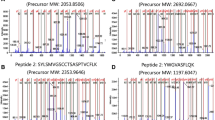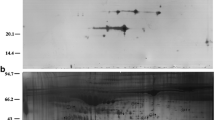Abstract
Embryo selection is a key point of in vitro fertilization (IVF). The most commonly used method for embryo selection is morphological assessment. However, it is sometimes inaccurate. Follicular fluid (FF) contains a complex mixture of proteins that are essential for follicle development and oocyte maturation. Analyzing human FF proteomic profiles and identifying predictive biomarkers might be helpful for evaluating embryo quality. A total of 22 human FF samples were collected from 19 infertile women who underwent IVF/intracytoplasmic sperm injection (ICSI) treatment between October 2021 and November 2021. FFs were grouped into two categories on the basis of the day 3 embryo quality, grade I or II in the hqFF group and grade III in the nhqFF group. FF was analyzed by liquid chromatography-tandem mass spectrometry (LC/MS/MS). The key differentially expressed proteins (DEPs) were validated by parallel reaction monitoring (PRM) and enzyme-linked immunosorbent assay (ELISA). Differentially expressed proteins were further analyzed using DAVID software. A total of 558 proteins were identified, of which 50 proteins were differentially expressed in the hqFF versus nhqFF group, including 32 upregulated proteins (> 1.20-fold, P < 0.05) and 18 downregulated proteins (< 0.67-fold, P < 0.05). Bioinformatics analyses showed that the upregulated DEPs were enriched in components of the coagulation and complement systems and negative regulation of peptidase activity, while the downregulated DEPs were enriched in molecular function of extracellular matrix structural and constituent collagen binding. Our results suggested that a number of protein biomarkers in FF were associated with embryo quality. It may help develop an effective and noninvasive method for embryo selection.






Similar content being viewed by others
Data Availability
The original contributions presented in the study are included in the article/Supplementary Material. Further inquiries can be directed to the corresponding authors.
Code Availability
Not applicable.
Abbreviations
- AMH:
-
Anti-Müllerian hormone
- CBG:
-
Corticosteroid binding globulin
- C1R:
-
Complement C1r subcomponent
- C7:
-
Complement component C7
- COCs:
-
Cumulus-oocyte complexes
- DDA:
-
Data-dependent acquisition
- DEP:
-
Differentially expressed protein
- FF:
-
Follicular fluid
- GCs:
-
Glucocorticoids
- GnRH:
-
Gonadotropin releasing hormone
- GO:
-
Gene Ontology
- ICSI:
-
Intracytoplasmic sperm injection
- ITIH1:
-
Inter-alpha-trypsin inhibitor heavy chain H1
- ITIH2:
-
Inter-alpha-trypsin inhibitor heavy chain H2
- IVF:
-
In vitro fertilization
- KEGG:
-
Kyoto Encyclopedia of Genes and Genomes
- LC/MS/MS:
-
Liquid chromatography–tandem mass spectrometry
- PPI:
-
Protein–protein interaction
- PRM:
-
Parallel reaction monitoring
- SERPIN:
-
Serine protease inhibitor
- SERPINA6:
-
Serine protease inhibitor A6
- SERPINC1:
-
Serpin peptidase inhibitor, clade C
- SHAP:
-
Serum-derived hyaluronan-associated proteins
- TMT:
-
Tandem mass tags
- VEGF:
-
Vascular endothelial growth factor
References
Nargund G, Datta AK. Maximizing live birth rates cannot be the only key performance indicator of IVF. Reprod BioMed Online. 2022;44:587–9.
Khalife D, Abu-Musa A, Khalil A, Ghazeeri G. Towards the selection of embryos with the greatest implantation potential. J Obstet Gynaecol. 2021;41:1010–5.
Fortune JE. Ovarian follicular growth and development in mammals. Biol Reprod. 1994;50:225–32.
Ambekar AS, Nirujogi RS, Srikanth SM, Chavan S, Kelkar DS, Hinduja I, et al. Proteomic analysis of human follicular fluid: a new perspective towards understanding folliculogenesis. J Proteome. 2013;87:68–77.
Jarkovska K, Martinkova J, Liskova L, Halada P, Moos J, Rezabek K, et al. Proteome mining of human follicular fluid reveals a crucial role of complement cascade and key biological pathways in women undergoing in vitro fertilization. J Proteome Res. 2010;9:1289–301.
Bayasula IA, Kobayashi H, Goto M, Nakahara T, Nakamura T, et al. A proteomic analysis of human follicular fluid: comparison between fertilized oocytes and nonfertilized oocytes in the same patient. J Assist Reprod Genet. 2013;30:1231–8.
Chen F, Spiessens C, D'Hooghe T, Peeraer K, Carpentier S. Follicular fluid biomarkers for human in vitro fertilization outcome: proof of principle. Proteome Sci. 2016;14:17.
Severino V, Malorni L, Cicatiello AE, D'Esposito V, Longobardi S, Colacurci N, et al. An integrated approach based on multiplexed protein array and iTRAQ labeling for in-depth identification of pathways associated to IVF outcome. PLoS One. 2013;8:e77303.
Kushnir MM, Naessén T, Wanggren K, Rockwood AL, Crockett DK, Bergquist J. Protein and steroid profiles in follicular fluid after ovarian hyperstimulation as potential biomarkers of IVF outcome. J Proteome Res. 2012;11:5090–100.
Estes SJ, Ye B, Qiu W, Cramer D, Hornstein MD, Missmer SA. A proteomic analysis of IVF follicular fluid in women < or = 32 years old. Fertil Steril. 2009;92:1569–78.
Shen X, Liu X, Zhu P, Zhang Y, Wang J, Wang Y, et al. Proteomic analysis of human follicular fluid associated with successful in vitro fertilization. Reprod Biol Endocrinol. 2017;15:58.
Alpha Scientists in Reproductive Medicine and ESHRE Special Interest Group of Embryology. The Istanbul consensus workshop on embryo assessment: proceedings of an expert meeting. Hum Reprod. 2011;26:1270–83.
Sun Y, Li L, Zhou Y, Ge W, Wang H, Wu R, et al. Stratification of follicular thyroid tumours using data-independent acquisition proteomics and a comprehensive thyroid tissue spectral library. Mol Oncol. 2022;16:1611–24.
Levi M, van der Poll T, Büller HR. Bidirectional relation between inflammation and coagulation. Circulation. 2014;109:2698–704.
Georgiou AS, Gil MA, Alminana C, Cuello C, Vazquez JM, Roca J, et al. Effects of complement component 3 derivatives on pig oocyte maturation, fertilization and early embryo development in vitro. Reprod Domest Anim. 2011;46:1017–21.
Hashemitabar M, Bahmanzadeh M, Mostafaie A, Orazizadeh M, Farimani M, Nikbakht R. A proteomic analysis of human follicular fluid: comparison between younger and older women with normal FSH levels. Int J Mol Sci. 2014;15:17518–40.
Gonzalès J, Lesourd S, Van Dreden P, Richard P, Lefèbvre G, Vauthier BD. Protein composition of follicular fluid and oocyte cleavage occurrence in in vitro fertilization (IVF). J Assist Reprod Genet. 1992;9:211–6.
Kim YS, Kim MS, Lee SH, Choi BC, Lim JM, Cha KY, et al. Proteomic analysis of recurrent spontaneous abortion: identification of an inadequately expressed set of proteins in human follicular fluid. Proteomics. 2006;6:3445–54.
Zhu L, Zhuo L, Watanabe H, Kimata K. Equivalent involvement of inter-alpha-trypsin inhibitor heavy chain isoforms in forming covalent complexes with hyaluronan. Connect Tissue Res. 2008;49:48–55.
Chen L, Mao SJ, McLean LR, Powers RW, Larsen WJ. Proteins of the interalpha-trypsin inhibitor family stabilize the cumulus extracellular matrix through their direct binding with hyaluronic acid. J Biol Chem. 1994;269:28282–7.
Huang L, Yoneda M, Kimata K. A serum-derived hyaluronan-associated protein (SHAP) is the heavy chain of the inter alpha-trypsin inhibitor. J Biol Chem. 1993;268:26725–30.
Hess KA, Chen L, Larsen WJ. The ovarian blood follicle barrier is both charge- and size-selective in mice. Biol Reprod. 1998;58:705–11.
Hess K‚Chen L‚Larsen J. Inter-alpha-inhibitor binding to hyaluronan in the cumulus extracellular matrix is required for optimal ovulation and development of mouse oocyte. Biol Reprod. 1999;61:436-443
Zhuo L, Yoneda M, Zhao M, Yingsung W, Yoshida N, Kitagawa Y, et al. Defect in SHAP-hyaluronan complex causes severe female infertility. A study by inactivation of the bikunin gene in mice. J Biol Chem. 2001;276:7693–6.
Meyer EJ, Nenke MA, Rankin W, Lewis JG, Torpy DJ. Corticosteroid-binding globulin: a review of basic and clinical advances. Horm Metab Res. 2016;48:359–71.
Bae YJ, Kratzsch J. Corticosteroid-binding globulin: modulating mechanisms of bioavailability of cortisol and its clinical implications. Best Pract Res Clin Endocrinol Metab. 2015;29:761–72.
Sapolsky RM, Romero LM, Munck AU. How do glucocorticoids influence stress responses? Integrating permissive, suppressive, stimulatory, and preparative actions. Endocr Rev. 2000;21:55–89.
Andersen CY, Hornnes P. Intrafollicular concentrations of free cortisol close to follicular rupture. Hum Reprod. 1994;9:1944–9.
Jimena P, Castilla JA, Peran F, Ramirez JP, Vergara F Jr, Molina R, et al. Adrenal hormones in human follicular fluid. Acta Endocrinol. 1992;127:403–6.
Prasad S, Tiwari M, Pandey AN, Shrivastav TG, Chaube SK. Impact of stress on oocyte quality and reproductive outcome. J Biomed Sci. 2016;29(23):36.
Simerman AA, Hill DL, Grogan TR, Elashoff D, Clarke NJ, Goldstein EH, Manrriquez AN, Chazenbalk GD, Dumesic DA. Intrafollicular cortisol levels inversely correlate with cumulus cell lipid content as a possible energy source during oocyte meiotic resumption in women undergoing ovarian stimulation for in vitro fertilization. Fertil Steril. 2015;103:249–57.
Andersen CY. Levels of steroid-binding proteins and steroids in human preovulatory follicle fluid and serum as predictors of success in in vitro fertilization-embryo transfer treatment. J Clin Endocrinol Metab. 1990;71:1375–81.
Acknowledgements
We thank all the patients for participating in this research.
Funding
This research was supported by the National Key Research and Development Project (2019YFA0802600) and the National Natural Science Foundation of China (82171599 and 81971333).
Author information
Authors and Affiliations
Contributions
BX and JJ conceived of the study. SB, BX, LH, and JJ participated in its design and coordination and reviewed the final manuscript for submission. JJ, XZ, LS, SB, and HW carried out the studies and drafted the manuscript. BX and SB carried out the bioinformatics analysis. LL participated in the study design and performed the HFF collection. All authors read and approved the final manuscript.
Corresponding author
Ethics declarations
Ethics Approval and Consent to Participate
The Ethics Committee of The First Affiliated Hospital of USTC approved this study protocol (2022-KY-354), and informed consent was obtained from each individual.
Consent for Publication
All authors consent to the publication of the manuscript.
Competing Interests
The authors declare no competing interests.
Additional information
Publisher’s Note
Springer Nature remains neutral with regard to jurisdictional claims in published maps and institutional affiliations.
Supplementary Information
ESM 1
(DOCX 26 kb)
Rights and permissions
Springer Nature or its licensor (e.g. a society or other partner) holds exclusive rights to this article under a publishing agreement with the author(s) or other rightsholder(s); author self-archiving of the accepted manuscript version of this article is solely governed by the terms of such publishing agreement and applicable law.
About this article
Cite this article
Ji, J., Zhu, X., Zhang, Y. et al. A Proteomic Analysis of Human Follicular Fluid: Proteomic Profile Associated with Embryo Quality. Reprod. Sci. 31, 199–211 (2024). https://doi.org/10.1007/s43032-023-01293-x
Received:
Accepted:
Published:
Issue Date:
DOI: https://doi.org/10.1007/s43032-023-01293-x




